
Publisher:
Bonnie King
CONTACT:
Newsroom@Salem-news.com
Advertising:
Adsales@Salem-news.com

~Truth~
~Justice~
~Peace~
TJP
May-25-2012 15:09

 TweetFollow @OregonNews
TweetFollow @OregonNews
Sri Lanka War Crimes-Genocide with West Complicity: an Analysis
Ron Ridenour Salem-News.comThis article focuses on military support the US, EU and Israel provided the repressive Sri Lankan government.
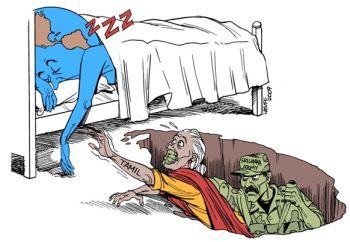 Artwork by the amazing Carlos Latuff, friend of Salem-News in Rio de Janeiro. See his work: Latuff Gallery |
(COPENHAGEN) - The US-UK axis is quite adroit at launching aggressive wars against governments and peoples who do not buckle under. Today’s method of domination is often linked with media propaganda about doing the right thing for “human rights”.
In the case of its ally Sri Lanka it did not need to send troops to win the war against Tamils struggles for liberation. The Western powers provided Sri Lankan governments military with weaponry, war intelligence and training to win the long war against Tamil nationhood. But, after the mutual victory, the axis also criticizes the current government for having committed excesses. This approach is the best of all possible worlds for Western dictates: world domination for the cause of humanity is what they say if you read between the lips of communicators for globalization George Bush- Barack Obama-Hilliary Clinton, Tony Blair-Gordon Brown-David Cameron.
While China and Russia also militarily and economically assisted Sri Lankan governments in avoiding federalism for the two peoples: majority Sinhalese and minority Tamils, they did so without the hyperbole of “protecting human rights”. Unfortunately, Cuba and its associates in the eight Latin American nations ALBA (Bolivarian Alliance of the peoples of the Americas) got caught up in the geo-political game by supporting Sri Lanka Sinhalese chauvinism politically but without funds and weapons.
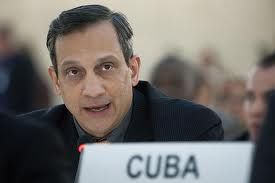 Cuba's Rodolfo Reyes Rodríguez |
Rodolfo Reyes Rodríguez, Cuba’s Permanent Representative to United Nations Office at Geneva, argued at the 19th session of the Human Rights Council (HRC), last March 22, that the United States acted contradictorily for presenting a resolution asking Sri Lanka to implement its own mild report, Lessons Learnt and Reconciliation Commission (LLRC), and slightly criticizing the government for not addressing human rights abuse that occurred during the end of the civil war between the government and the Liberation Tigers of Tamil Eelam (LTTE).
(See article about this at: http://www.havanatimes.org/?p=
Rodríguez ridiculed the US position given that, as he said, 40% of military hardware sold to Sri Lankan governments between 1983 and 2009 (the duration of the war for liberation) came from it and its closest allies, the UK and http://www.unmultimedia.org/
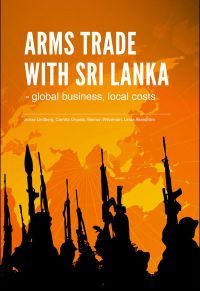 |
“Why do they doubt Sri Lanka after having sold so many weapons?” Rodríguez inquired. While Cuba backed Sri Lanka 100%, disregarding the plight of over two million Tamils, its ambassador considered the US resolution as “interference” into the affairs of the sovereign state.
An excellent book, Arms Trade with Sri Lanka: global business, local costs put out by the Swedish Peace and Arbitration Society and the Swedish Sri Lanka Committee (http://www.svenskafreds.se/
Between 1999 and 2008, the largest military equipment (towed guns, tanks, fighter and trainer and transport aircraft, helicopters, fast sea craft, mines, radar, missiles and rockets, armored bridge layers, surveillance and communication equipment) came from China and Russia, later also Ukraine and Iran—on the one end of the spectrum—and from the US and nine EU states on the other end. Military suppliers also included Pakistan and India from the middle.
This article focuses on military support the US, EU and Israel provided the repressive Sri Lankan governments. Moreover, the US and EU are Sri Lanka’s greatest economic trading partners.
Israel
The Zionist State—which practices genocide against the Palestinians whose right to self-determination was recognized by 46 governments on the HRC during the 19th session with only the US voting against—hardly comes into the spotlight when the Sri Lanka-Tamil conflict is discussed.
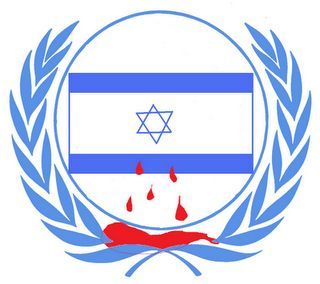
Nevertheless, “Israel has been a faithful supplier to Sri Lanka” serving the military, commerce and politics, as the Swedish book maintains.
The most decisive sales and donations in the latter years of war came from Israel (and China). A vast number of combat aircraft—nine of 24 since 2000; 16 Kfir jets in all—and many of the ships (especially six Super Dvora and 38 Shaldag fast patrol craft) used by Sri Lanka came from Israel. It also supplied seven unmanned vehicles, 16 anti-ship mines, communication and surveillance equipment, and great quantities of ammunition; plus pilots and Mossad intelligence agents.
Makhdoom Babar, editor-in-chief of the pro-Sri Lanka government Daily Mail reported that Israel uses Sri Lanka waters to test their missiles. http://www.dailymailnews.com/
A 2009 SIPRI report, “International Arms Transfers”, shows that between 2000 and 2007, Sri Lanka acquired “several large warships from India, Israel and the USA”. The Swedish-based international arms conflict monitor reported that Israel has been a major and effective arms supplier. http://www.sipri.org/yearbook/
Mossad-Israel military intelligence also played an important role in preventing Tamils from gaining their liberation. In the 1980s Israeli experts advised Sri Lanka to create border villages and arm Sinhala civilians as home guards. This is what the US also did in parts of Southeast Asia during its genocidal war in the 1960s-70s.
Economic Union
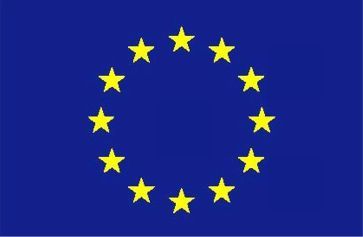
EU sale of weaponry to Sri Lanka has violated its code of conduct on arms export since it was enacted in 1998 to prevent aiding and abetting human rights abuse. As if to compensate for its hypocrisy, the EU lifted part of the Generalized System of Preferences (GSP) in August 2010 due to Sri Lanka’s “poor human rights record”. But EU still offers “limited tariff preferences” to Sri Lankan imports.
Despite this lessened export tax break, the EU continues to be a major market (SL largest apparel buyer), and the island’s economy grew by 8%, in 2010, thanks to loans from the IMF.
During the last decade of war, France provided several small sea craft. Czech Republic sold 16 rocket systems and 52 tanks. Slovakia is, after the UK, the only European country that publicizes its military sales to SL after the restart of the war, in 2006. It lists the sale of 10,000 rockets worth £1 million. http://www.state.gov/r/pa/ei/
A June 2, 2009 article, “UK sold arms to Sri Lanka during Tamil Tiger conflict”, points out the hypocrisy of European governments in voicing criticism of human rights abuse while they continue to sell arms to the Sri Lankan mass murdering regime. http://www.
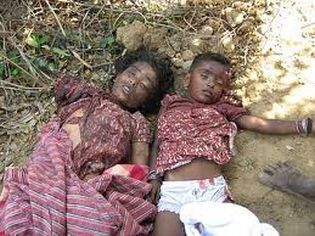
In 2008, the UK approved £4 million worth of weaponry including armored vehicles, pistols and machine guns, and 12 large naval guns.
At the close of the war, the EU Observer reported:
"The EU is appalled by the loss of innocent civilian lives as a result of the conflict and by the high numbers of casualties, including children, following recent intense fighting in northern Sri Lanka," said European foreign ministers in a statement, 18 May, 2009. http://euobserver.com/13/28155.
"The EU calls for the alleged violations of these laws to be investigated through an independent inquiry," the statement continued. "Those accountable must be brought to justice."
Nevertheless, EU member states - including Bulgaria, the Czech Republic, Slovakia, the UK, France, Italy, Lithuania, the Netherlands and Poland - had armed the Sri Lankan government since the election of Mahinda Rajapaksa, in 2005.
“According to the EU's latest report on arms export licenses published in December, the nine governments authorized arm sales licenses to Sri Lanka to the value of €4.09 million in 2007 [small weapons, ammunition, explosives, missiles, vehicles, naval vessels, aircraft], the same year that Colombo launched its final offensive on the Tamil rebels.”
Australia is among the western suppliers to Sri Lanka. It granted $52.5 million in development assistance (2010-11) [http://www.dfat.gov.au/geo/
“U.S. Military Assistance to Countries Using Child Soldiers, 1990-2007”
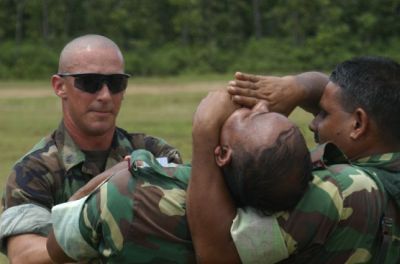 US Army training Sri Lanka soldiers. Courtesy: JDSLanka.org |
This Center for Defense Information report (above sub-head) shows how the United States continues to supply military support to many countries, including Sri Lanka, when the government or its paramilitary allies recruit children to war against opponents, despite United Nations ban on such support:
“The U.S. Department of State’s Country Reports on Human Rights Practices” shows where it supplied military assistance between 1990 and 2007, and often to states that commit human atrocities: “the United States continues to provide millions of dollars in Foreign Military Sales (FMS), Direct Commercial Sales (DCS), Excess Defense Articles (EDA), International Military Education and Training (IMET), and Foreign Military Financing (FMF).”
A CDI chart shows that the US sold (or donated) $143 million in military aid to Sri Lanka’s military in the 17-year period. US foreign military sales, in 2007, were $60.8 million—the greatest amount for any single year—plus $1.44 million was spent on military training and financing. Green Berets were used since 1996 in “Operation Balanced Style” to train soldiers.
Contrary to claims that the US cut off military sales or assistance, it has not done so. Between 2007 and 2009, the US sold a few cutters, radar systems, and 300 trucks. It also sold helicopters, some of which were made in Canada. (Canada also sold small arms amounting to less than $1 million in 2007-9.) The US did cut back sales in 2009 but the 2010-12 fiscal year budget calls for nearly $3 million in Foreign Military Financing and International Military Education and Training. http://www.fas.org/sgp/crs/
Economic and Military sales and assistance continue despite the fact that the US admits that the Sri Lanka government and its paramilitary allies practice torture, murder, disappearances, child recruiting and other brutalities. The US Department of State’s Bureau of Democracy, Human Rights, and Labor report of March 6, 2007 reads:
- “The [Sri Lanka] government's respect for the human rights of its citizens declined due in part to the breakdown of the CFA [Cease-Fire Accord of 2002]. Credible sources reported human rights problems, including unlawful killings by government agents, high profile killings by unknown perpetrators, politically motivated killings by paramilitary forces associated with the government and the LTTE, and disappearances. Human rights monitors also reported arbitrary arrests and detention, poor prison conditions, denial of fair public trial, government corruption and lack of transparency, infringement of religious freedom, infringement of freedom of movement, and discrimination against minorities. There were numerous reports that armed paramilitary groups linked to government security forces participated in armed attacks, some against civilians... the government strengthened emergency regulations that broadened security forces' powers in the arrest without warrant and non-accountable detention of civilians for up to 12 months.” http://www.state.gov/j/drl/rls/hrrpt/2006/78875.htm
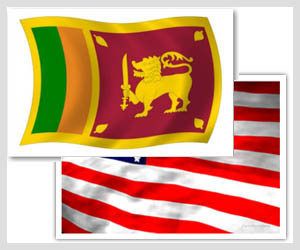
The US State Department’s April 6, 2011 “Background Note on Sri Lanka” shows that the US has steadily supported Sri Lanka militarily and has benefited economically from trade.
“Exports to the United States, Sri Lanka's most important single-country market, were estimated to be around $1.77 billion for 2010, or 21% of total exports. The United States is Sri Lanka's second-biggest market for garments, taking almost 40% of total garment exports.” http://www.state.gov/r/pa/ei/bgn/5249.htm
“U.S. assistance has totaled more than $2 billion since Sri Lanka's independence in 1948…In addition the International Broadcast Bureau (IBB)--formerly Voice of America (VOA)--operates a radio-transmitting station in Sri Lanka. The U.S. Armed Forces maintain a limited military-to-military relationship with the Sri Lanka defense establishment.”
Even as it publicly expressed some criticism of Sri Lanka for not implementing its own investigation into possible human rights abuse, the Obama administration backed a $213 million World Bank loan last March for Colombo development.
US assisted in annihilating Tamils
In January 2006—just weeks after the Rajapaksa-led government had come to power—then US ambassador, Jeffrey Lunstead, warned the LTTE that if it refused a settlement on Colombo's terms it would face "a stronger, more capable and more determined Sri Lankan military."
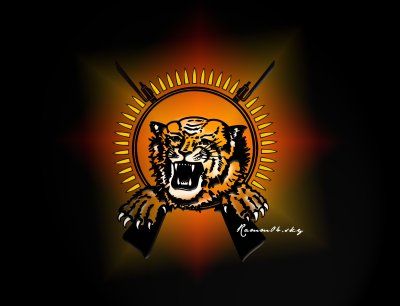 |
Lunstead added: "Through our military training and assistance programs, including efforts to help with counter-terrorism initiatives and block illegal financial transactions, we are helping to shape the ability of the Sri Lankan government to protect its people and defend its interests."
For such support, Sri Lanka signed the Access and Cross Servicing Agreement in March 2007 that allows US warships and aircraft to use facilities in Sri Lanka. Combined support by the US and its allies, as well as China-Pakistan-Iran immense sums of military armaments, weakened the ability of the LTTE to hold its ground. This led to the “liberation” of Kilinochchi, “the city that for a decade had served as the capital of the LTTE-controlled enclave in parts of the island's north and east,” as Keith Jones wrote. (http://www.globalresearch.ca/index.php?context=va&aid=11769)
“Last Wednesday [January 7, 2009], the US embassy in Colombo issued a statement that welcomed the Sri Lankan state's recent victories in the war…and urged Sri Lanka's government and military to press forward with the annihilation of the LTTE. The key passage in the statement read: ‘The United States does not advocate that the Government of Sri Lanka negotiate with the LTTE, a group designated by America as a Foreign Terrorist Organization since 1997.’"
“US pressure was critical in getting Canada, the states of the European Union, and other countries to proscribe the LTTE. These bans have deprived the LTTE of financial support from the hundreds of thousands of Tamils chased from their island homes by the civil war,” Jones continued.
“The new-found prowess of the Sri Lanka military is due almost entirely to the support it has received from Washington directly or from key US allies.”
The United States and its allies thoroughly supported Sri Lanka governments, allowing genocide and aiding in war crimes, and now dawns a façade of “concern for human rights”.
Conclusion
US-UK axis hypocritical complicity should lead Tamils and their supporters everywhere to change strategy in the struggle for justice.
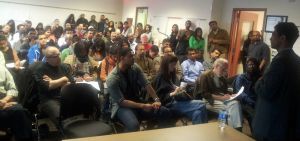 |
Sinhala academic Dr. Jude Lal Fernando speaking in Toronto recently on the “Tamil struggle for self-determination: a leftist Sinhala perspective” compared the success of the peace process in Ireland to the failure of the peace process (2002-6) in Sri Lanka. His conclusion, as summarized in: http://www.tamilnet.com/art.html?catid=13&artid=35097 shows how it was primarily the US-UK axis that prevented a peaceful solution in which autonomy (some at least for Tamils) could have been the outcome for both sides. And he spoke of a new strategy.
The negotiations in Ireland were based on “parity of status” between the warring parties while in Sri Lanka neither the Sri Lankan Mahinda Rajapaksa government nor the US-UK axis allowed for parity and that is why the LTTE did not surrender arms and sometimes engaged the government army in battle during the cease-fire.
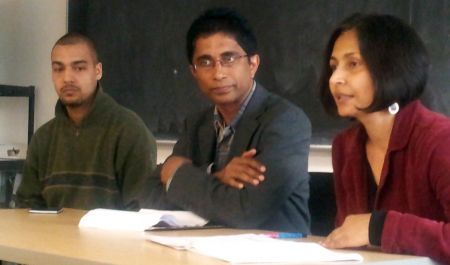 |
In the case of the warring parties in Ireland, the Clinton regime allowed representatives of the Catholic liberation forces to meet the Irish Diaspora in the US and to negotiate equally. In contrast, the Bush regime forbad the LTTE to enter its territory. Dr. Fernando argues that the former treatment bolstered the confidence of the Irish Republican Army in the peace process, while the latter treatment resulted in the opposite, and thus the US is as “blameworthy for the 2009 massacre” as is the Rajapaksa regime. This also includes the role of UK-EU since its 2006 ban on the LTTE made explicit a military solution by the Sri Lanka Freedom Party and its allies.
Dr. Fernando was a key coordinator of the Dublin Permanent People’s Tribunal in Sri Lanka, which, in January 2010, concluded that Sri Lankan governments had committed war crimes and crimes against humanity, and that the issue of genocide should be investigated.
The “tactic employed by the Sri Lankan government, aided and abetted by the international community, was to bomb the Tamil people until they were ‘reduced to a survival instinct’ but not to the human instinct of demanding freedom. In this light, the entire reality of the 2009 genocide has been misconstrued and misrepresented to the world as simply a military operation against terrorism. On the contrary, the peace process itself confirmed that the Tamil national question is a legitimate political question and not a terrorist problem”, asserted Fernando, according to Tamil Net.
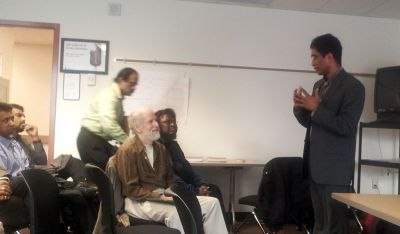 |
Finally, Fernando speaks directly to the erroneous tactic of many Tamil groups in the Diaspora. He maintains that many have been deceived by the US sponsored resolution at the Human Rights Council. The pro-LLRC resolution does not oppose or even mention the root causes of the national question, nor the history of genocide. In fact, it accepts the legitimacy of waging war to protect the sovereignty of the state, which is, ironically, the same position as Cuba-ALBA, Russia and China.
By launching a slight criticism of the state, without going to the core of the matter, the US-UK axis diverts attention away from the real causes of the long-standing conflict: nationalist Sinhalese chauvinism, racism, religious intolerance, and the “right” to practice discrimination and genocide.
“Instead of trying to align itself with international powers, the Diaspora must stand on its own two feet and say that the aspirations of the Tamils uncompromisingly remain the same based on the principles of nation, homeland, and self-determination,” concludes Fernando.
Notes:
1. Israel is, in fact, the world’s fourth largest arms seller: $7.3 billion sold in 2010. http://disarmtheconflict.wordpress.com/israeli-arms/israeli-exports/). The US government is the greatest weapons exporter at $31.6 billion (http://www.warisbusiness.com/2720/research/us-arms-exports-to-the-muslim-world/). Much of the armaments that Israel sells come from the US.
2. “Rudd ignores war crimes and boost ties with Sri Lanka,” Sam King, February 19, 2010.
3. The CDI was founded in 1972 as an independent non-NGO monitoring institution of US and international security defense policy.
May 25, 2012
Ron Ridenour is a veteran journalist and author of nine books, the latest is, “Tamil Nation in Sri Lanka” http://www.ronridenour.com/books/tamil_nation_in_sri_lanka.htm
 Ron Ridenour was born in the devil's own country, he rejected the American Dream and became a solidarity and revolutionary activist and writer nearly half-a-century ago. Ridenour has worked as a journalist-editor-author-translator for three decades. He worked for Cuba's Editorial José Martí and Prensa Latina for eight years, and has published five books about Cuba, as well as Yankee Sandinistas. Born to a WASP military career father, Ron sought the “American Dream” until he entered the Air Force, in 1956, to fight the “commies”.
Ron Ridenour was born in the devil's own country, he rejected the American Dream and became a solidarity and revolutionary activist and writer nearly half-a-century ago. Ridenour has worked as a journalist-editor-author-translator for three decades. He worked for Cuba's Editorial José Martí and Prensa Latina for eight years, and has published five books about Cuba, as well as Yankee Sandinistas. Born to a WASP military career father, Ron sought the “American Dream” until he entered the Air Force, in 1956, to fight the “commies”.
Here, Ronald witnessed approved segregated barracks on a U.S. military in Japan, and imposition of racism in Japanese establishments. This, and the fact that his group had orders to shoot down any Soviet aircraft over “their” territory in Japan—which never appeared—while the U.S. flew spy planes over the Soviet Union daily, led this writer to question American “morality”. The first time Ronald exercised his democratic right to demonstrate was in Los Angeles, where he protested with others the Yankee invasion of Cuba, at the Bay of Pigs. Cuba’s revolution, and his hate for racism, which led Ronald to become a radical, then a revolutionary.
 |
 |
 |
 |
 |
 |
 |
Articles for May 24, 2012 | Articles for May 25, 2012 | Articles for May 26, 2012

Quick Links
DINING
Willamette UniversityGoudy Commons Cafe
Dine on the Queen
Willamette Queen Sternwheeler
MUST SEE SALEM
Oregon Capitol ToursCapitol History Gateway
Willamette River Ride
Willamette Queen Sternwheeler
Historic Home Tours:
Deepwood Museum
The Bush House
Gaiety Hollow Garden
AUCTIONS - APPRAISALS
Auction Masters & AppraisalsCONSTRUCTION SERVICES
Roofing and ContractingSheridan, Ore.
ONLINE SHOPPING
Special Occasion DressesAdvertise with Salem-News
Contact:AdSales@Salem-News.com

Salem-News.com:
googlec507860f6901db00.html

Terms of Service | Privacy Policy
All comments and messages are approved by people and self promotional links or unacceptable comments are denied.
Rajaguru KB May 27, 2012 7:46 pm (Pacific time)
Thanks Ron for bringing light to this burning genocide, We Tamils are still innocent lambs trusting butchers! Nowhere to go... all governments were behaved as enimies and only the people who belive in human values are with us.... with their support our struggle for freedom will never doom!
[Return to Top]©2025 Salem-News.com. All opinions expressed in this article are those of the author and do not necessarily reflect those of Salem-News.com.